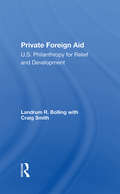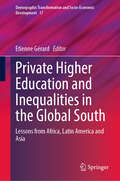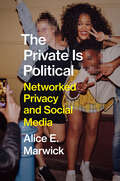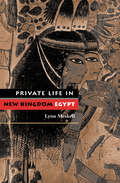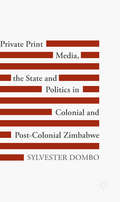- Table View
- List View
Private Equity and Financial Development in Latin America (Latin American Political Economy)
by Ignacio PuenteShallow capital markets are a key bottleneck for private sector development in Latin America. Still, there is not a large literature on capital markets and corporate governance, or on the politics of regulatory reform and business associations, focused on this region. To help address this gap, this new book introduces private equity into the financial development debate through a Latin American lens. The author looks at the cases of Brazil, Mexico, Chile, Colombia, and Argentina. And proposes a shift in the financial development discussion from institutional explanations focused only on rules to an actor-based argument centered on the role of institutional investors, in particular pension funds .
Private Foreign Aid: U.s. Philanthropy In Relief And Developlment
by Landrum R Bolling Craig SmithOver the past 150 years, Americans have responded repeatedly to the needs of people in foreign lands, providing aid in times of natural disaster, in the wake of war, in the development of resources, in the eradication of disease and poverty and in the battle against hunger. This challenging task has been tackled again and again by churches, corpora
Private Foreign Aid: U.s. Philanthropy In Relief And Developlment
by Landrum R Bolling Craig SmithOver the past 150 years, Americans have responded repeatedly to the needs of people in foreign lands, providing aid in times of natural disaster, in the wake of war, in the development of resources, in the eradication of disease and poverty and in the battle against hunger. This challenging task has been tackled again and again by churches, corpora
Private Higher Education and Inequalities in the Global South: Lessons from Africa, Latin America and Asia (Demographic Transformation and Socio-Economic Development #17)
by Etienne GérardBased on original findings from research carried out in six low- and middle-income countries in Africa, Asia and Latin America, this book brings together conceptual and empirical analyses of private higher education and social and academic inequality, a topic largely unexplored in the social science literature, particularly on private higher education. Field surveys of different categories of actors in numerous private universities have combined common methods and tools in countries chosen for the differences in their social structures and the characteristics, organization and development of their private higher education systems. Based on these qualitative surveys, combined with available quantitative data on higher education, this book analyzes the production and reproduction of social and academic inequalities in countries as diverse as Argentina, Mexico, Peru, the Democratic Republic of Congo, Senegal and Vietnam. Finally, the historical and social structuringof the private education systems in the selected countries provides the framework for analyses that go beyond the traditional higher education demand/supply and public policy approaches to explore the perspective of the actors – institutional administrators, teaching staff and students.
Private Honour and Noble Masculine Image in Early Modern England: Sir Robert Sidney and His Contemporaries (Routledge Studies in Renaissance Literature and Culture)
by Erika D'SouzaRobert Sidney, the first Earl of Leicester (1563–1626), serves as an exemplar of an Elizabethan nobleman who had in his collection a body of work pertinent to the subject of masculine honour in the private realm. Understanding the nuances and evolution of the term private honour as it is represented in Sidney’s artefacts, as well as in the public discourse of the era, is the work and contribution of this book. The permeability between the private and public spheres led to an emergence of new forms of masculine representation. In a time when manhood was intertwined with militaristic qualities (such as courage, strength and fortitude), my investigation shows that in the domestic sphere, a gentler version of masculinity, encouraging humility, constancy and modesty, was fostered amongst the nobility. While worries of effeminacy certainly existed, there also was a strong discourse that encourage men to adopt so-called feminine virtues within the private sphere.
Private Honour and Noble Masculine Image in Early Modern England: Sir Robert Sidney and His Contemporaries (Routledge Studies in Renaissance Literature and Culture)
by Erika D'SouzaRobert Sidney, the first Earl of Leicester (1563–1626), serves as an exemplar of an Elizabethan nobleman who had in his collection a body of work pertinent to the subject of masculine honour in the private realm. Understanding the nuances and evolution of the term private honour as it is represented in Sidney’s artefacts, as well as in the public discourse of the era, is the work and contribution of this book. The permeability between the private and public spheres led to an emergence of new forms of masculine representation. In a time when manhood was intertwined with militaristic qualities (such as courage, strength and fortitude), my investigation shows that in the domestic sphere, a gentler version of masculinity, encouraging humility, constancy and modesty, was fostered amongst the nobility. While worries of effeminacy certainly existed, there also was a strong discourse that encourage men to adopt so-called feminine virtues within the private sphere.
The Private Is Political: Networked Privacy and Social Media
by Alice E. MarwickA compelling firsthand investigation of how social media and big data have amplified the close relationship between privacy and inequality Online privacy is under constant attack by social media and big data technologies. But we cannot rely on individual actions to remedy this—it is a matter of social justice. Alice E. Marwick offers a new way of understanding how privacy is jeopardized, particularly for marginalized and disadvantaged communities—including immigrants, the poor, people of color, LGBTQ+ populations, and victims of online harassment. Marwick shows that few resources or regulations for preventing personal information from spreading on the internet. Through a new theory of “networked privacy,” she reveals how current legal and technological frameworks are woefully inadequate in addressing issues of privacy—often by design. Drawing from interviews and focus groups encompassing a diverse group of Americans, Marwick shows that even heavy social media users care deeply about privacy and engage in extensive “privacy work” to protect it. But people are up against the violation machine of the modern internet. Safeguarding privacy must happen at the collective level.
Private Justice: Towards Integrated Theorising in the Sociology of Law (Routledge Revivals)
by Stuart HenryThis book, first published in 1983, looks at discipline in industry and shows how private justice is integrally bound up with formal law. It is a timely examination of the forms of social control that exist ostensibly outside the formal legal system but on which it crucially depends. Private Justice: Towards Integrated Theorising in the Sociology of Law will be of interest to students of law, sociology, and criminology. Dr. Stuart Henry is currently Professor and Director of the School of Public Affairs at San Diego State University where he has been since 2006. Since leaving Trent Polytechnic (now Nottingham Trent University) in 1983 he has held positions in the United States at Eastern Michigan University, Wayne State University, and the University of Texas at Arlington. He is the author or editor of 30 books and over 100 articles on crime, deviance and social control.
Private Justice: Towards Integrated Theorising in the Sociology of Law (Routledge Revivals)
by Stuart HenryThis book, first published in 1983, looks at discipline in industry and shows how private justice is integrally bound up with formal law. It is a timely examination of the forms of social control that exist ostensibly outside the formal legal system but on which it crucially depends. Private Justice: Towards Integrated Theorising in the Sociology of Law will be of interest to students of law, sociology, and criminology. Dr. Stuart Henry is currently Professor and Director of the School of Public Affairs at San Diego State University where he has been since 2006. Since leaving Trent Polytechnic (now Nottingham Trent University) in 1983 he has held positions in the United States at Eastern Michigan University, Wayne State University, and the University of Texas at Arlington. He is the author or editor of 30 books and over 100 articles on crime, deviance and social control.
Private Lawyers and the Public Interest: The Evolving Role of Pro Bono in the Legal Profession
by Robert Granfield Lynn MatherThis collection of original essays by leading and emerging scholars in the field examines the history, conditions, organization, and strategies of pro bono lawyering. Private Lawyers and the Public Interest: The Evolving Role of Pro Bono in the Legal Profession traces the rise and impact of the American Bar Association's campaign to hold lawyers accountable for a commitment to public service and to encourage public service within law schools. Combining empirical legal research with reflections by practitioners and theorists about the meaning and practice of pro bono legal work, this collection of essays interrogates the public service ideals that are inscribed within the legal profession and places these ideals within a broader social, economic, ideological, and normative context. Particular attention is paid to the factors that explain why lawyers engage in pro bono work and the ways in which their views of pro bono are mediated by the institutional context of their legal practice. The book also explores the concept of "public" in public service and compares pro bono as a means of delivering legal services with other mechanisms such as state funding. Collectively, these essays investigate the evolving role of pro bono in the legal profession and in law schools, the relationship between pro bono ideals and pro bono in practice, the way that pro bono is shaped by external forces beyond the individual practitioner, and the multi-faceted nature of legal professionalism as expressed through pro bono practice.
Private Lawyers and the Public Interest: The Evolving Role of Pro Bono in the Legal Profession
by Robert Granfield and Lynn MatherThis collection of original essays by leading and emerging scholars in the field examines the history, conditions, organization, and strategies of pro bono lawyering. Private Lawyers and the Public Interest: The Evolving Role of Pro Bono in the Legal Profession traces the rise and impact of the American Bar Association's campaign to hold lawyers accountable for a commitment to public service and to encourage public service within law schools. Combining empirical legal research with reflections by practitioners and theorists about the meaning and practice of pro bono legal work, this collection of essays interrogates the public service ideals that are inscribed within the legal profession and places these ideals within a broader social, economic, ideological, and normative context. Particular attention is paid to the factors that explain why lawyers engage in pro bono work and the ways in which their views of pro bono are mediated by the institutional context of their legal practice. The book also explores the concept of "public" in public service and compares pro bono as a means of delivering legal services with other mechanisms such as state funding. Collectively, these essays investigate the evolving role of pro bono in the legal profession and in law schools, the relationship between pro bono ideals and pro bono in practice, the way that pro bono is shaped by external forces beyond the individual practitioner, and the multi-faceted nature of legal professionalism as expressed through pro bono practice.
Private Life in New Kingdom Egypt
by Lynn MeskellMuch of the literature on ancient Egypt centers on pharaohs or on elite conceptions of the afterlife. This scintillating book examines how ordinary ancient Egyptians lived their lives. Drawing on the remarkably rich and detailed archaeological, iconographic, and textual evidence from some 450 years of the New Kingdom, as well as recent theoretical innovations from several fields, it reconstructs private and social life from birth to death. The result is a meaningful portrait composed of individual biographies, communities, and landscapes. Structured according to the cycles of life, the book relies on categories that the ancient Egyptians themselves used to make sense of their lives. Lynn Meskell gracefully sifts the evidence to reveal Egyptian domestic arrangements, social and family dynamics, sexuality, emotional experience, and attitudes toward the cadences of human life. She discusses how the Egyptians of the New Kingdom constituted and experienced self, kinship, life stages, reproduction, and social organization. And she examines their creation of communities and the material conditions in which they lived. Also included is neglected information on the formation of locality and the construction of gender and sexual identity and new evidence from the mortuary record, including important new data on the burial of children. Throughout, Meskell is careful to highlight differences among ancient Egyptians--the ways, for instance, that ethnicity, marital status, age, gender, and occupation patterned their experiences. Readers will come away from this book with new insights on how life may have been experienced and conceived of by ancient Egyptians in all their variety. This makes Private Life in New Kingdom Egypt unique in Egyptology and fascinating to read.
Private Life in New Kingdom Egypt(PDF)
by Lynn MeskellMuch of the literature on ancient Egypt centers on pharaohs or on elite conceptions of the afterlife. This scintillating book examines how ordinary ancient Egyptians lived their lives. Drawing on the remarkably rich and detailed archaeological, iconographic, and textual evidence from some 450 years of the New Kingdom, as well as recent theoretical innovations from several fields, it reconstructs private and social life from birth to death. The result is a meaningful portrait composed of individual biographies, communities, and landscapes. Structured according to the cycles of life, the book relies on categories that the ancient Egyptians themselves used to make sense of their lives. Lynn Meskell gracefully sifts the evidence to reveal Egyptian domestic arrangements, social and family dynamics, sexuality, emotional experience, and attitudes toward the cadences of human life. She discusses how the Egyptians of the New Kingdom constituted and experienced self, kinship, life stages, reproduction, and social organization. And she examines their creation of communities and the material conditions in which they lived. Also included is neglected information on the formation of locality and the construction of gender and sexual identity and new evidence from the mortuary record, including important new data on the burial of children. Throughout, Meskell is careful to highlight differences among ancient Egyptians--the ways, for instance, that ethnicity, marital status, age, gender, and occupation patterned their experiences. Readers will come away from this book with new insights on how life may have been experienced and conceived of by ancient Egyptians in all their variety. This makes Private Life in New Kingdom Egypt unique in Egyptology and fascinating to read.
The Private Lives of the Saints: Power, Passion and Politics in Anglo-Saxon England
by Janina RamirezSkulduggery, power struggles and politics, The Private Lives of the Saints offers an original and fascinating re-examination of life in Anglo-Saxon England. Taking them from their heavenly status to the human level, Oxford art historian and BBC presenter Dr Janina Ramirez explores the real lives of over a dozen seminal saints. This landmark book provides a unique and captivating lens through which to explore the rich history of the Dark Ages.
Private Madhouses in England, 1640–1815: Commercialised Care for the Insane (Mental Health in Historical Perspective)
by Leonard SmithThis book examines the origins and early development of private mental health-care in England, showing that the current spectacle of commercially-based participation in key elements of service provision is no new phenomenon. In 1815, about seventy per cent of people institutionalised because of insanity were being kept in private ‘madhouses’. The opening four chapters detail the emergence of these madhouses and demonstrate their increasing presence in London and across the country during the long eighteenth century. Subsequent chapters deal with specific aspects in greater depth - the insane patients themselves, their characteristics, and the circumstances surrounding admissions; the madhouse proprietors, their business activities, personal attributes and professional qualifications or lack of them; changing treatment practices and the principles that informed them. Finally, the book explores conditions within the madhouses, which ranged from the relatively enlightened to the seriously defective, and reveals the experiences, concerns and protests of their many critics.
Private Medicine And Public Health: Profit, Politics, And Prejudice In The American Health Care Enterprise
by Lawrence D WeissThis book surveys the broad expanse of health and health care institutions in America from a critical, macro, political-economic, and social problems-oriented perspective. It presents a political-economic analysis that is a deeper analysis of the political influences exercised by industry.
Private Medicine And Public Health: Profit, Politics, And Prejudice In The American Health Care Enterprise
by Lawrence D WeissThis book surveys the broad expanse of health and health care institutions in America from a critical, macro, political-economic, and social problems-oriented perspective. It presents a political-economic analysis that is a deeper analysis of the political influences exercised by industry.
Private Oceans: The Enclosure and Marketisation of the Seas (Anthropology, Culture and Society)
by Fiona McCormackAs the era of thriving, small-scale fishing communities continues to wane across waters that once teamed with (a way of) life, Fiona McCormack opens a window into contemporary fisheries quota systems, laying bare how neoliberalism has entangled itself in our approach to environmental management. *BR**BR*Grounded in fieldwork in New Zealand, Iceland, Ireland and Hawaii, McCormack offers up a comparative analysis of the mechanisms driving the transformations unleashed by a new era of ocean grabbing. Exploring the processes of privatisation in ecosystem services, Private Oceans traces how value has been repositioned in the market, away from productive activities. The result? The demise of the small-scale sector, the collapse of fishing communities, cultural loss, and the emergence of a newly propertied class of producers - the armchair fisherman. *BR**BR*Ultimately, Private Oceans demonstrates that the deviations from the capitalist norm explored in this book offer grounds for the reimagining of both fisheries economies and broader environmental systems.
Private Oceans: The Enclosure and Marketisation of the Seas (Anthropology, Culture and Society)
by Fiona McCormackAs the era of thriving, small-scale fishing communities continues to wane across waters that once teamed with (a way of) life, Fiona McCormack opens a window into contemporary fisheries quota systems, laying bare how neoliberalism has entangled itself in our approach to environmental management. *BR**BR*Grounded in fieldwork in New Zealand, Iceland, Ireland and Hawaii, McCormack offers up a comparative analysis of the mechanisms driving the transformations unleashed by a new era of ocean grabbing. Exploring the processes of privatisation in ecosystem services, Private Oceans traces how value has been repositioned in the market, away from productive activities. The result? The demise of the small-scale sector, the collapse of fishing communities, cultural loss, and the emergence of a newly propertied class of producers - the armchair fisherman. *BR**BR*Ultimately, Private Oceans demonstrates that the deviations from the capitalist norm explored in this book offer grounds for the reimagining of both fisheries economies and broader environmental systems.
Private Policing: Powers, Culture And Control In The Governance Of Private Space
by Mark ButtonThe second edition of Private Policing details the substantial involvement of private agents and organisations involved in policing beyond the public police. It develops a taxonomy of policing and explores in depth each of the main categories, examining the degree of privateness, amongst several other issues. The main categories include the public police; hybrid policing such as state policing bodies, specialised police forces and non-governmental organisations; voluntary policing; and the private security industry. This book explores how the public police and many other state bodies have significant degrees of privateness, from outright privatisation through to the serving of private interests. The book provides a theoretical framework for private policing, building upon the growing base of scholarship in this area. Fully revised, this new edition not only brings the old edition up to date with the substantial scholarship since 2002, but also provides more international context and several new chapters on: corporate security management, security officers, and private investigation. There is also a consideration of what the book calls the ‘new private security industry’ working largely in cyber-space. Bringing together research from a wide range of projects the author has been involved with, along with the growing body of private policing scholarship, the book shows the substantial involvement of non-public police bodies in policing and highlights a wide range of issues for debate and further research. Private Policing is ideal reading for students of policing and security courses, academics with an interest in private policing and security, and practitioners from security and policing.
Private Politics and Peasant Mobilization: Mining in Peru (Development, Justice and Citizenship)
by Maria-Therese GustafssonThis book explores how different corporate governance strategies affect community mobilization and the scope for influence when an area’s population is faced with the arrival of the extraction industry. Drawing on ethnographic research into Peruvian mining localities, the author analyses a series of relationships which are characterized by confrontations, clientelism, demobilization and strategic collaboration. By presenting a detailed account of micro practices and showing how these processes are interpreted by different groups, Gustafsson offers a refined understanding of the multiple layers and informal workings of power between transnational corporations and local communities.
Private Power and Centralization in France: The Notaires and the State
by Ezra N. SuleimanBy examining the relationship between the notaires, members of a significant French legal profession with deep roots in French history, and the state, Ezra Suleiman demonstrates that clientelism exists and may be more dangerous in a centralized state than in a decentralized one.Originally published in 1988.The Princeton Legacy Library uses the latest print-on-demand technology to again make available previously out-of-print books from the distinguished backlist of Princeton University Press. These editions preserve the original texts of these important books while presenting them in durable paperback and hardcover editions. The goal of the Princeton Legacy Library is to vastly increase access to the rich scholarly heritage found in the thousands of books published by Princeton University Press since its founding in 1905.
Private Print Media, the State and Politics in Colonial and Post-Colonial Zimbabwe
by Sylvester DomboThis book examines the role played by two popular private newspapers in the struggle for democracy in Zimbabwe, one case from colonial Rhodesia and the other from the post-colonial era. It argues that, operating under oppressive political regimes and in the dearth of credible opposition political parties or as a platform for opposition political parties, the African Daily News, between 1956-1964, and the Daily News, between 1999-2003, played an essential role in opening up spaces for political freedom in the country. Both newspapers were ultimately shut down by the respective government of the time. The newspapers allowed reading publics the opportunity to participate in politics by providing a daily analytical alternative, to that offered by the government and the state media, in relation to the respective political crises that unfolded in each of these periods. The book further examines both the information policies pursued by the different governments and the way these affected the functioning of private media in their quest to provide an "ideal" public sphere. It explores issues of ownership, funding and editorial policies in reference to each case and how these affected the production of news and issue coverage. It considers issues of class and geography in shaping public response. It also focuses on state reactions to the activities of these newspapers and how these, in turn, affected the activities of private media actors. Finally, it considers the cases together to consider the meanings of the closing down of these newspapers during the two eras under discussion and contributes to the debates about print media vis-à-vis the new forms of media that have come to the fore.
Private Print Media, the State and Politics in Colonial and Post-Colonial Zimbabwe
by Sylvester DomboThis book examines the role played by two popular private newspapers in the struggle for democracy in Zimbabwe, one case from colonial Rhodesia and the other from the post-colonial era. It argues that, operating under oppressive political regimes and in the dearth of credible opposition political parties or as a platform for opposition political parties, the African Daily News, between 1956-1964, and the Daily News, between 1999-2003, played an essential role in opening up spaces for political freedom in the country. Both newspapers were ultimately shut down by the respective government of the time. The newspapers allowed reading publics the opportunity to participate in politics by providing a daily analytical alternative, to that offered by the government and the state media, in relation to the respective political crises that unfolded in each of these periods. The book further examines both the information policies pursued by the different governments and the way these affected the functioning of private media in their quest to provide an "ideal" public sphere. It explores issues of ownership, funding and editorial policies in reference to each case and how these affected the production of news and issue coverage. It considers issues of class and geography in shaping public response. It also focuses on state reactions to the activities of these newspapers and how these, in turn, affected the activities of private media actors. Finally, it considers the cases together to consider the meanings of the closing down of these newspapers during the two eras under discussion and contributes to the debates about print media vis-à-vis the new forms of media that have come to the fore.
Private Prisons: Cons and Pros
by Charles H. LoganAmerican prisons and jails are overflowing with inmates. To relieve the pressure, courts have imposed fines on overcrowded facilities and fiscally strapped governments have been forced to release numerous prisoners prematurely. In this study, noted criminologist Charles Logan makes the case for commercial operation of prisons and jails as an alternative to the government's monopoly. On philosophical, economic, legal, and practical grounds, Logan argues a compelling case for the private and commercial operation of prisons. He critically examines all objections raised by opponents, and concludes that while private prisons face many potential problems, they do so primarily because they are prisons, not because they are private. Historically, the record of private ownership and operation of corrections facilities has been bleak--ridden with political corruption, physical abuse of prisoners, and the single-minded pursuit of profits. This study demonstrates that this need not be the case. Critiquing the tendency to contrast private prisons with a hypothetical ideal, Logan instead compares them with existing public institutions, arguing that the potential problems attributed to private prisons are experienced by their public counterparts. The work examines ten sets of issues, including the propriety, cost, security, and quantity of prisons, to set out a strong case for the viability of proprietary prisons.

